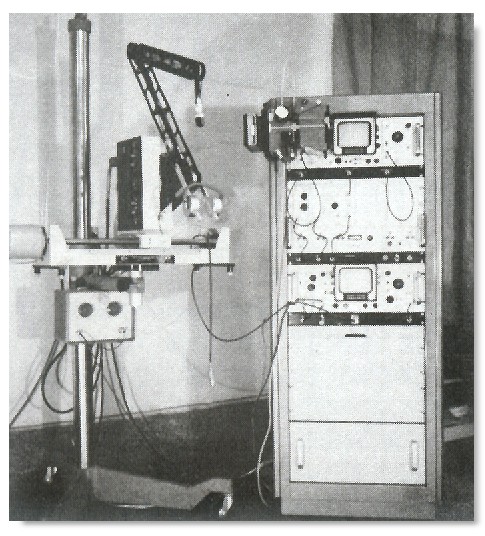
The Pickers

The elephant-trunk articulated-arm scanning gantry and console from an early Picker® scanner, the Laminograph, circa 1970. The storage oscilloscope is in the top rack position. The machine has evolved from the Porta-Scan articulated-arm scanner manufactured by the Physionics Engineering?Inc. at Longmont, Colorado in the mid 1960s, designed and built by William Wright and Ralph Edward Meyerdirk who were formerly with the University of Colorado. Physionics was sold to the Picker Corporation (see below).
The electronics console still has the very large configuration reminescent of the early designs of Howry and Posakony in the 1950s, as a result of the size of the vaccum tube circuitry and electronics at the time. The scanner operates a 2.0 MH focused lead zirconate half inch diameter transducer with a Tektronix storage oscilloscope (screen - 8 x 10 cm). The original scanning arm assembly is now mounted on a motorized rail where the whole assembly can move horizontally to a new position along the axis of the scanning plane. The articulated-arm format proved to be the most popular format in compound contact B-scanners throughout the world.

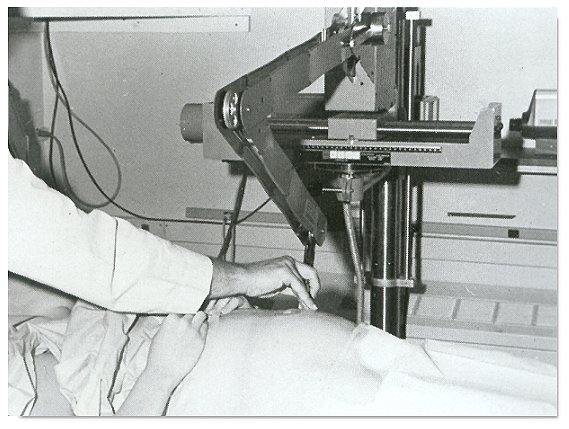
The scanner arm assembly of a slightly later version, stronger material was use without the large perforations for more sturdy and hence more accurate operation. C.1973.
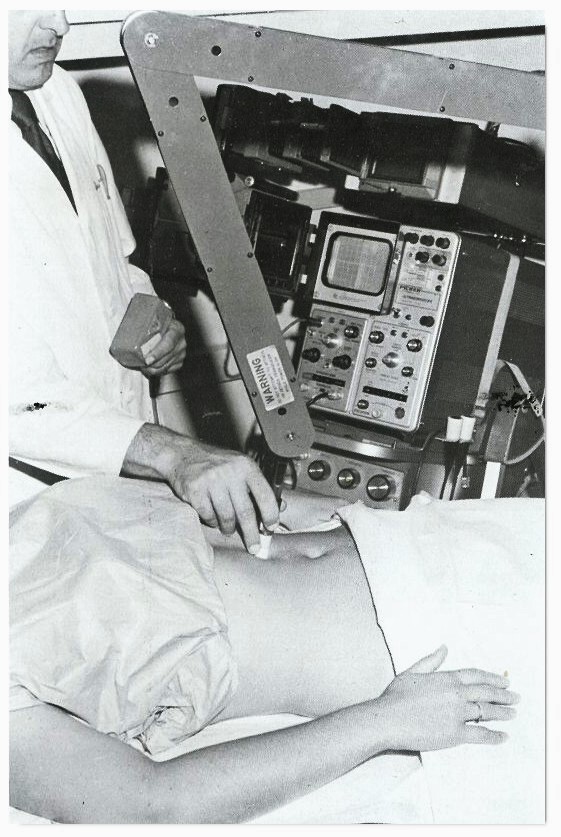
The scanner arm assembly with the A- and B-scope units in the background. The whole electronics console has reduced considerably in size.
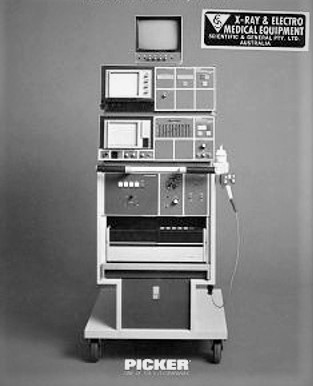
A third version of the Picker scanner incoporating an analogue scan converter and gray scale. C. 1975. The display (on the right hand side) was black-on-white, which was popular in the early days of gray-scale (late 1970s) in the United States.
A slightly later and very popular version, the "80L digital imager" (1979) runs with a digital scan converter.

Placeta Previa imaged with the newer Picker scanner incoporating an analogue scan converter and gray scale. C. 1975. The image quality was significantly improved. (The image was black-on-white) **
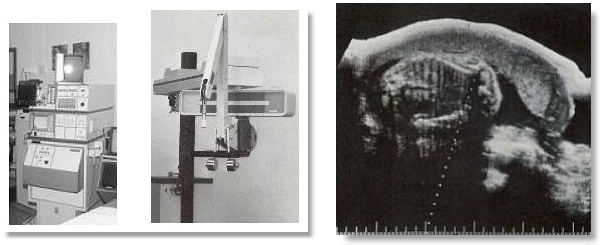
The console and scanner assembly of the Picker 80L digital Imager and the image from this machine. C.1980. Image quality was further improved.
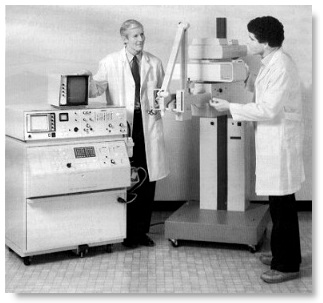
The newest and last Picker static scanner in the mid 1980s, the "Digital Imager ll". Also has real-time capabilities. Excellent resolution and operability. Finally had to give way to the stand-alone real-time scanners.
In Denver, Colorado in the early 1960s, Douglas Howry and Joseph Homles, together with consulting engineers William Wright and Ralph Meyerdirk, came up with a prototype multi-joint compound contact scanner where the transducer could be positioned and moved over the scanning area by the operator. In 1962, Wright and Meyerdink left the University to form the Physionics Engineering Inc. at Longmont, Colorado, and the first commercially available, hand-held articulated arm (with position mechanisms at each joint ) compound contact scanner was produced in the United States. Physionics was acquired by the Picker Corporation.
In 1981, Picker was acquired by General Electric Co. Ltd. of England (GEC). Picker merged with Cambridge Instruments, GEC Medical, and American Optical to form Picker International. In the 70's and early 80's Picker International became a very strong producer of gray-scale static B-mode ultrasound scanners. As the real-time scanners replaced the static scanners in the early to mid-80s, Picker did not pursue its own product line. In 1983, Picker entered into a sales relationship with Universal Medical Systems, a distributer of ultrasound equipment to sell the portable Ausonics (Mytus) ultrasound mechanical sector scanner under the Picker label. The company was also selling Hitachi /Ecoscan EUB range of linear array products from Japan under the Picker label. These were the last of Picker's marketed ultrasound products.
In 1985, Universal entered into a direct distributorship relationship with Ausonics PTY, Limited, an Australian developer and manufacturer of high quality portable ultrasound imaging equipment. This relationship grew to the point, where in 1987, Universal became the largest distributor of Ausonicsultrasound products in North and South America.
In the same year Picker International moved away from ultrasound completely and ending its 20 plus years of leadership in the ultrasound field. It became a market leader in both CT amd MR imaging. In 1986, the company produced the industry's first 1.0T MR imager. In 1998, Picker acquired the Computed Tomography Division of Elscint Ltd., immediately positioning the company at the forefront of major global CT suppliers. In 1999, the company unveils the new Marconi Medical Systems name and corporate vision. In 2001, Philips acquired Marconi Medical Systems.
* from "The use of Ultrasonography in Obstetrics and Gynecology", LM Hellman, M Kobayashi, et al. In Fundamentals of Medical Ultrasonography, G. Baum ed. 1975, GP Putnam's Sons, new York.
** from "Sonography in Obstetrics", R Sanders, M Conrad. In Radiologic Clinics of North America. R Sanders ed. 1975. W. B. Saunders Co.
Back to History of Ultrasound in Obstetrics and Gynecology.